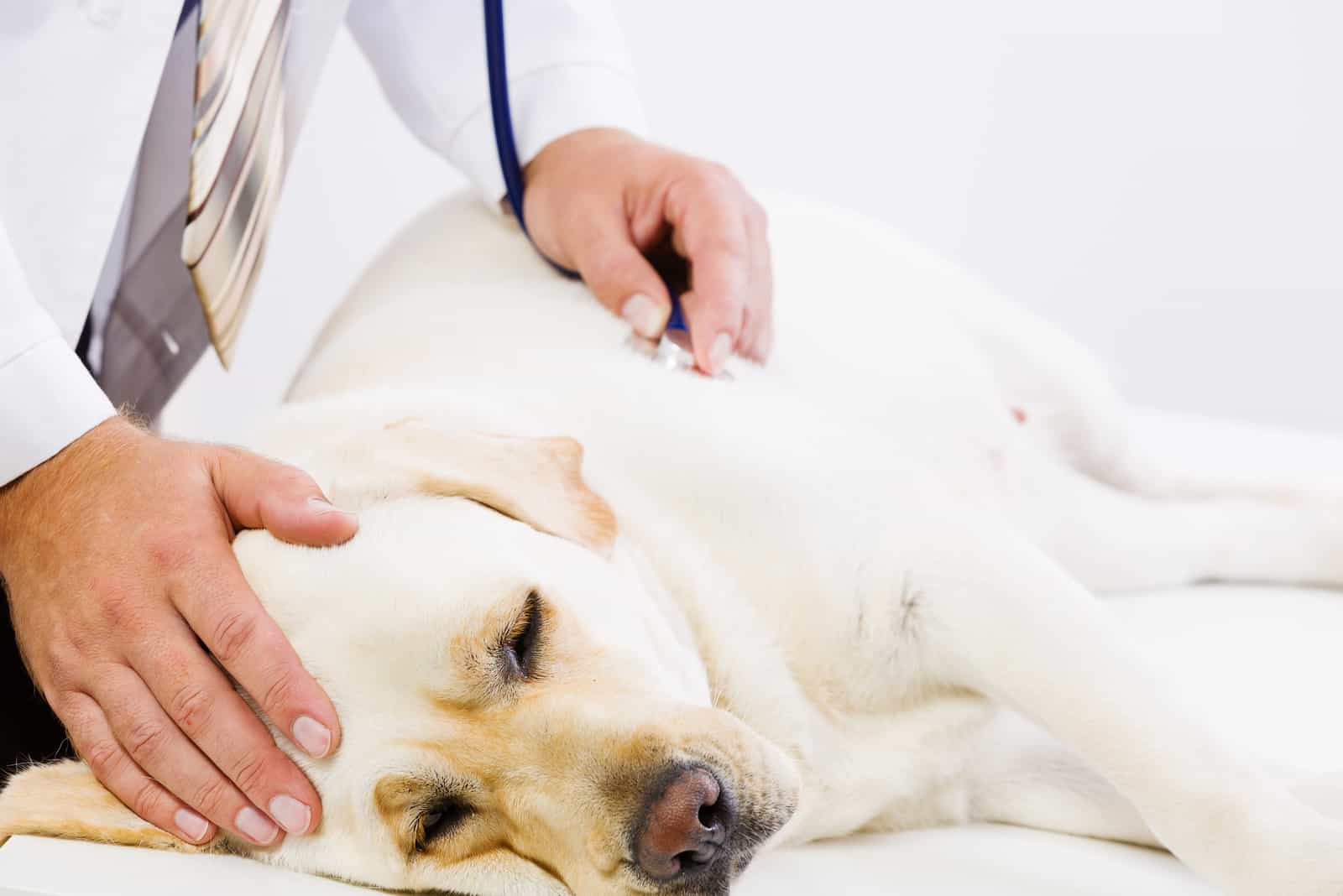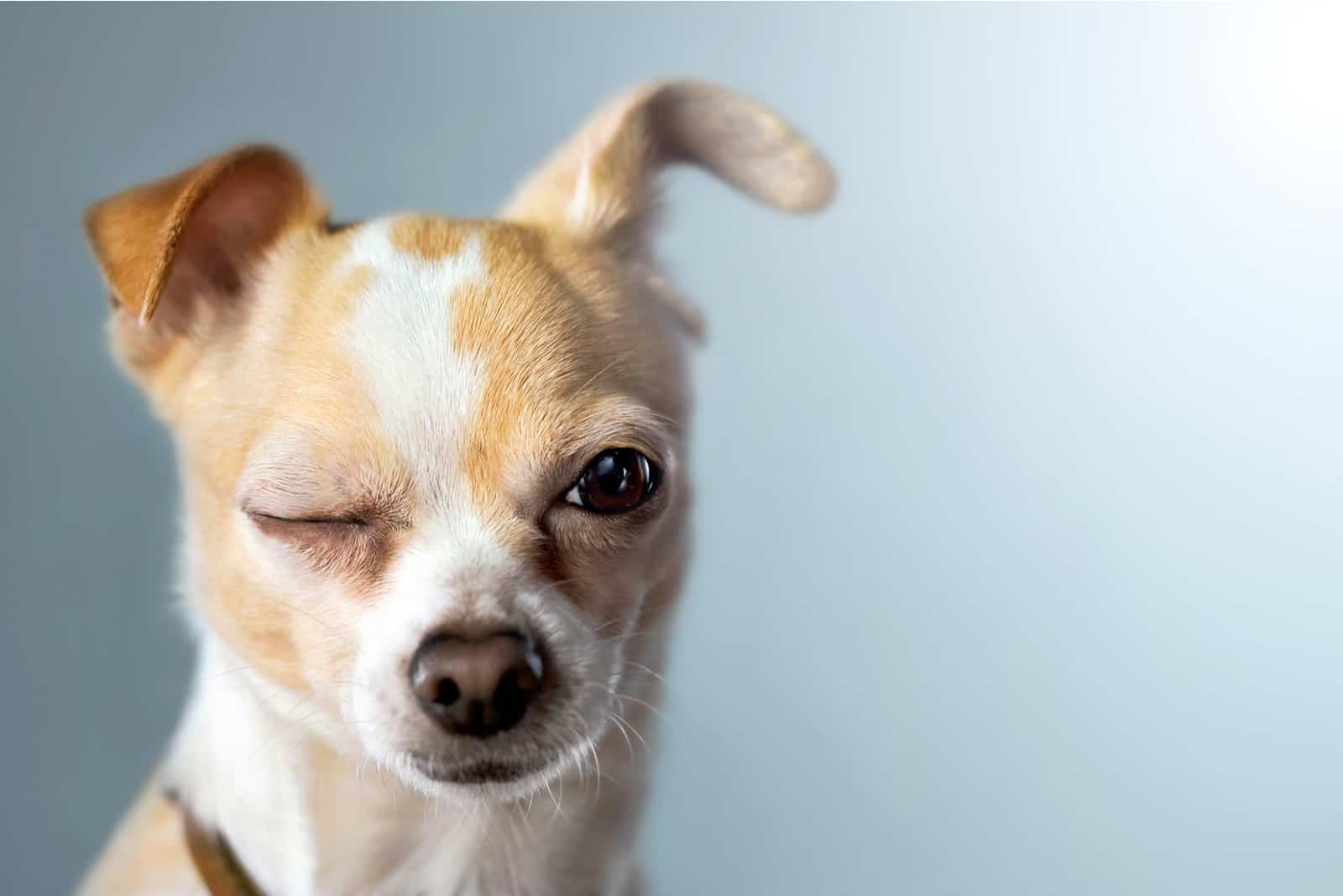Some sights are known to terrify all dog owners. Looking at your dog lying in the dog bed with his eyes rolling back in his head is certainly one of them. This can make your dog appear possessed!
Or, even worse – you’re in the middle of playtime just to see your dog’s eyes rolling back, and the only thing visible are the whites of his eyes!
There are many reasons why this is happening. Just because you see dog’s eyes rolling back doesn’t necessarily mean that something terrible is happening or that your dog’s life is at risk.
However, this is a sign that you should report to your vet, especially if it’s something that keeps on happening.
Why Are My Dog’s Eyes Rolling Back?

A dog’s eyes rolling back is an abnormal eye movement that, unfortunately, can be a symptom of many health problems. Many are challenging to discover without a proper medical examination, which is why it is necessary to take your dog to the vet.
However, if you notice only one eye rolling back, this is likely a sign of an entirely different thing, and it’s something we’ll talk about a bit later.
Here are some of the medical conditions and other things that might cause your dog’s eyes to roll back:
Nystagmus
Nystagmus is a medical condition that causes involuntary eye movements. Usually, the cause of nystagmus is a problem in the sensory system. This is the same system responsible for providing balance to the dog’s head and body.
There are two types of nystagmus in dogs:
1. Jerk Nystagmus, in which the eyes move slowly into one direction before suddenly jerking the opposite way. Out of the two, this is the more common type.
2. Pendular Nystagmus, in which the eyes oscillate back and forth in small movements and at the same speed.
Other than eye movements, common signs of nystagmus are head tilting and circling. This is because the dog’s head is trying to keep up with what the eyes are seeing.
Sometimes, nystagmus can look as if your dog’s eyes are rolling back. As nystagmus can appear suddenly (although it is usually present from birth), it can traumatize a dog owner.
Nystagmus can be genetic. It can also be caused by a problem in the dog’s nervous system, and the cause of this might be physical trauma, hypothyroidism, tumors, or exposure to certain toxins, such as lead.
The prognosis and recovery vary depending on what’s causing the condition, as well as how old the dog is.
Medications
A dog’s eyes rolling back can be a side effect of certain medications – most notably, painkillers and tranquilizers.
If your dog has recently been put on tranquilizers and you’ve noticed his eyes rolling back, don’t panic. Many medications have severe side effects that include extreme relaxation and lethargy. These can make your dog roll his eyes.
However, all decent vets should inform you about the possible side effects of taking any type of medication, including painkillers. You should always strive to get a product with the least amount of side effects, and for this, a vet should take your dog’s medical history and health condition into consideration.
If your dog ends up on medication, always read the instructions located inside the box, and follow the proper dosage. If you give your pooch the wrong dose of medication, you can cause severe harm to him.
Tumors
Sometimes, unusual eye movements can be a sign of tumors. Some tumors can affect the neurological system. As such, they can cause some severe health conditions, such as nystagmus.
Also, tumors can cause abnormal growth in either the eyelid or in the haw, but don’t confuse them with mostly harmless cysts.
Cysts can also be what causes strange eye movements. Cysts are usually located under the dog’s skin or in the tissues, organs, and bones.
Some tumors can cause cysts – even though cysts on their own aren’t connected with cancer of any form. Because of this, you should take your dog to the vet if you notice any lumps under their skin or in the eye area.
Seizures

Seizures happen because of abnormal brain activity. This is where the brain misinterprets an electrical impulse, triggering muscle movements in a certain area of the body depending on the part of the brain that is affected.
You can recognize a seizure because a dog will become unnaturally stiff, lose consciousness, start shaking uncontrollably, or even collapse suddenly.
However, some seizures – the so-called ‘silent seizures’ – might affect only a single body part, such as the eyes. Because of this, they are mostly unnoticed.
While seizures are not painful, they might confuse your dog and set him into panic mode. If this happens, your beloved pooch might not even recognize you.
Contrary to what many people think, dogs won’t swallow their tongues during seizures. Don’t ever try to open their mouth to save them from suffocating. You won’t help them, and the only thing that might happen is that your dog might accidentally bite you – or you might hurt him by accident.
A dog that is seizing may start drooling uncontrollably, which is another sign that can let you know what is happening.
Also, some canines might predict a seizure. They will start behaving anxiously or even whine up to 24 hours before a seizure happens.
Most seizures are triggered by some pre-existing medical conditions. These include:
• Epilepsy
• Infections
• Traumas
• Ingestion of infected animals or toxins
If your dog has never had a seizure before, wait until the seizure is over, then take him to the vet. If this has happened before, usually you can simply call a vet and ask them how you should behave. They might advise you to bring your dog in for further examinations.
While you can give your dog medications that will help with the seizing, the only way you can entirely eliminate seizures is to find the core issue and deal with it accordingly.
Unfortunately, some seizures are idiopathic, and there doesn’t seem to be any reason behind them whatsoever.
Vestibular Disease
Another condition that might cause your dog’s eyes to roll back is vestibular disease.
The vestibular system is located in the brain, but some of its peripheral components, such as the middle ear or inner ear, are located inside the dog’s ears. This system is responsible for providing balance to the dog’s body.
Sometimes, an infection might affect the inner or middle ear, causing vestibular disease. The symptoms of this disease are similar to nystagmus, which is why you might think your dog’s eyeballs are rolling back.
Other than that, the affected dog might have a loss of balance, which will lead to him appearing confused. Dogs with this abnormality might struggle to walk straight, their head will tilt to the side, and they might even lose their balance entirely and fall.
Overall, you might feel as if your dog is drunk, especially if he struggles to get up.
Other than infections, vestibular disease can also be caused by hypothyroidism, tumors, or injuries – but sometimes it is impossible to locate the precise cause.
Vestibular disease is more common in old dogs (which is why it’s also called old dog vestibular disease), but it can affect young dogs as well.
If you notice signs of vestibular disease, you should take your dog to the vet as soon as possible. The first 24 to 48 hours are critical to the dog’s recovery. If you manage to get your dog to the vet quickly enough, you can expect your dog to recover in up to three weeks – although some minor symptoms, such as head tilting or wobbling, might remain for the rest of its life.
Unfortunately, sometimes the causes of vestibular disease are rather severe, and they might require hospitalization.
Strokes
A stroke is one of the most severe health conditions that can end in a dog’s eyes rolling back. It is caused when the blood supply to the brain is suddenly interrupted.
There are two types of stroke:
1. Ischemic, which happens when there is an obstruction of a blood vessel.
2. Hemorrhagic, which occurs when a blood vessel ruptures.
Older dogs are more prone to strokes than younger adult dogs. However, large-breed dogs are prone to spinal cord strokes.
All strokes can cause loss of balance, seizures, and blindness, as well as abnormal eye movements.
Unfortunately, you cannot predict a stroke. Your dog might be acting entirely normal before a stroke happens. It can even happen to a seemingly healthy dog during playtime.
If your dog has a stroke, you need to get him to the vet as soon as possible. If your pup gets veterinary care on time, recovery rates are high. However, your dog would have to undergo treatment that will reduce the chances of a stroke happening again.
Eye Injury

Sometimes, you may see the dog’s eyes rolling back because the dog is in severe pain. This pain can come from anywhere on the dog’s body, but most of the time, it is caused by an injury to the cornea.
Your dog’s eyes might sometimes end up with small wounds and scratches, which are likely to cause terrible pain to the dog.
If you see your dog’s eyes rolling back, look for the following signs:
• Whining and barking for a prolonged period of time
• Feeling lethargic
• Losing interest in food
• Losing interest in activities
• Acting anxiously
• Being restless, even during the night
• Lying in unusual positions
• Unable to lie down
While dogs react to pain differently, these are some of the most common signs that your dog is hurting. The best thing to do is look for abnormal behaviors in dogs. A dog that is in pain will express behaviors that aren’t usual for him, and this is something you may easily notice.
Of course, if you suspect your dog is in pain, you need to get him to the vet as soon as possible. There are many conditions that cause pain, from conjunctivitis to cancer, that might not be able to be detected without thorough analysis.
Dog With One Eye Rolled Back In Its Head

If you see only one of your dog’s eyes being rolled back, although this looks scary, it’s usually nothing to worry about. In fact, most of the time, it isn’t a dog’s eyes rolling back, but rather how their nictitating membrane is behaving.
The nictitating membrane, also known as the third eyelid, is something not many dog owners are aware of. Dogs don’t have two, but rather three eyelids. The third one can be seen if you lift your dog’s eyelid when he’s sleeping, or if you wake it up abruptly.
The nictitating membrane is usually white in color, but this can vary. Unlike the other two eyelids, it closes over the eye diagonally.
It serves as a shield for the eye, and it protects it from various debris, helps fight infections, and sweeps away any mucus. In fact, the dog’s third eyelid gland membrane is responsible for approximately 40% of tears that your dog’s eyes produce.
Unfortunately, as the third eyelid is the first line of defense when it comes to your pup’s eyes, it is usually the first one to get hit by various infections.
Many eye problems in not just dogs but other animals, such as cats or eagles, are, in fact, related to the third eyelid. Some are genetic, but others indicate that there might be some underlying causes that need to be discovered.
Cherry Eye
The most common nictitating membrane health problem is cherry eye that occurs when the third eyelid gland prolapses. The eye may be red or swollen.
Dogs are more prone to this condition than most other animal species. It can affect both eyes equally, and some research shows that dogs younger than two seem to be more prone to it – although there is no definite proof of that.
Some of the dog breeds that are prone to cherry eye are Bulldogs, Beagles, Cocker Spaniels, Pugs, and even Golden Retrievers! However, experts are still uncertain as to whether this is a genetic condition.
Cherry eye is a condition that is easy to diagnose. A vet will closely inspect the nictitating membrane, which will usually be producing a huge amount of tears and discharge. Ironically, if the disease isn’t treated on time, it can end with dry eye syndrome.
Cherry eye can be treated with medications and manual massage manipulation. However, while it lasts, you might think that you’re dealing with your dog’s eyes rolling back – or at least one of their eyes.
If the condition keeps on appearing, your dog might require surgery, as the gland will have to be entirely replaced.
Strabismus
A common cause of a dog’s eyes rolling back is strabismus. Strabismus in dogs is quite similar to strabismus in humans. It causes the dog’s eyes to seemingly go in different directions because the eye muscles cannot work together due to the brain not being able to control them properly.
It is essential to know the reason behind strabismus. Sometimes, dogs with strabismus don’t need treatment. However, if it suddenly appears and makes it look as if the dog’s eyes are rolling back, this might be a sign of concern.
Most of the time, strabismus is a hereditary condition. In fact, some dog breeds are rather prone to it and it is considered a desirable trait!
However, strabismus might also be the result of vestibular disease, tumors, or head injuries. It is also more common in old dogs.
Strabismus alone doesn’t cause any discomfort or pain for your dog, and it is merely a cosmetic issue as these dogs have a funny look to them. Despite this, these pups will be able to live long and healthy lives.
Do Dog’s Eyes Roll Back When They Sleep?

Just like most humans, dogs roll their eyes back when they sleep. This is a perfectly natural eye movement, and it happens to nearly every dog out there.
Sometimes, this movement can trigger the dog’s third eyelid, which will partially open your dog’s eyes. This can make it seem as if your dog’s eyes are entirely rolled back into his head, even though this isn’t the case!
The third eyelid is the reason why some dogs appear as if their eyes have been entirely rolled back when they nap.
Read Next: 7 Reasons For Dog Side Eye And Dogs That Have Perfected It
Dog’s Eyes Rolling Back In The Head, And Shaking While Sleeping
The event mentioned above seems especially concerning if your dog is shaking. Having his eyes rolled back and his entire body in tremors might make him appear possessed, or as if he’s having a seizure.
Most of the time, however, your dog is simply dreaming. Yes, just like humans, dogs can dream.
Dreams happen in the rapid eye movement (REM) phase, when your dog’s eyes have the highest chance of being rolled back. When dogs dream, they might move their paws or even their entire body, making it seem as if they’re shaking.
If you are afraid for your dog’s health, gently wake it up, and try not to startle it. If a dog acts in the usual manner once he is awake, then he was simply chasing after squirrels in his mind.
If the tremors continue when the dog is awake, take him to the vet as soon as possible.
My Dog’s Eyes Roll Back – Can I Help Him?

Photo from: @whereskaia
If you see your dog’s eyes rolling back, the best thing you can do is take him to the vet who will examine him and try to find the cause of this abnormality. Without proper examination, you won’t find the cause and be able to provide your pooch with proper treatment.
Unusual eye movements don’t have to mean anything serious. However, they can also be a sign of many diseases and conditions that will have a great negative impact on your dog’s health. This includes cherry eye, strokes, and tumors.
Some health conditions that cause a dog’s eyes to roll back are genetic. Others happen for various reasons, including old age.
Sometimes, you might think you’re seeing your dog’s eyes rolling back, but what you’re actually looking at is the third eyelid peaking. The eye may be red or swollen.
Still, the best option would be to take your dog to the vet. Uncontrolled eye movements might be a sign of grave diseases, and you wouldn’t want to risk it.
Read More:
• Why Do Dogs Wink? – 7 Possible Reasons
• Horner’s Syndrome In Dogs – An Eyelid Issue Or A Serious Problem?













